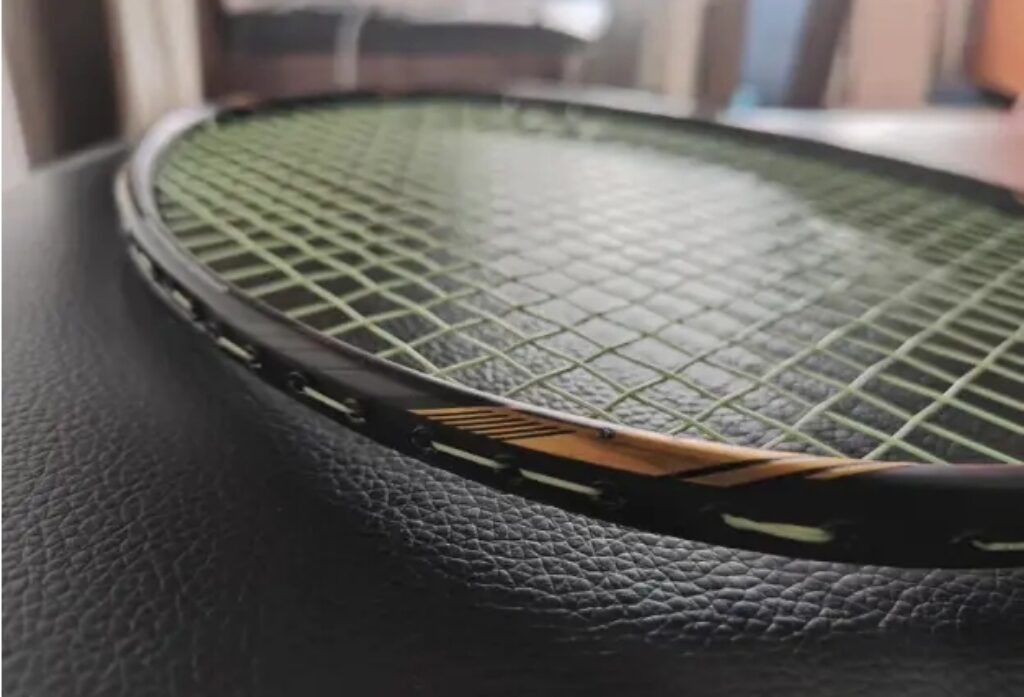Feeling spontaneous and starting something, only to find that once you begin, you can’t go back—this happens often. Just like how, after trying the Wind Storm 4000B and Wind Blade 300 and feeling pleased, I got the idea to explore the entire series for performance differences, leading to a new small goal.
One must accept the possibility of making mistakes, having poor performance, and the reality of struggling financially while pursuing these goals.
Specifications:
- Weight: 4UG5
- No base grip
- Total Weight (used condition): 93.0g
- Balance Point: 300mm
- Length: 670mm
- Shaft Length: 210mm
- Stiffness: Moderate
- Frame: Box frame
- String Bed: 72-hole
- String Groove: 9-3 o’clock
- Warranty: 30 pounds
- Recommended String Tension: 25-26 lbs VBS70P
This is also a second-hand racket, and mid-range rackets typically show more wear, as users are less likely to treat them as carefully as high-end models. Without a suffix, this racket is from the earliest release of the series (2017). The black base paint and yellow stickers, with minimal other decorations, give it a dull appearance, quite different from the later 4000B (2019) style. The shaft has minor changes, but the total length is only 670mm, which is shorter compared to mainstream models, possibly inspired by the 88S to adapt to doubles play.
Though labeled as 4U, the racket feels more like a 3U model in terms of swing. Low-end models typically have only two wind tunnels, which don’t significantly improve swing speed. I agree with the notion that “making a hole is not as good as making the frame thinner.” The short shaft increases the difficulty of driving, and the shaft’s normal performance feels wooden. The head has some weight, but the string bed’s sweet spot is consistently large, making the entry level manageable. However, the enjoyment of hitting is not very noticeable.
In terms of feel, it remains within the balanced racket series comparable to the Wind Storm. The ball control feels substantial, likely due to the VBS70P string.

The racket is responsive and performs well in terms of torsion resistance and forgiveness. The feel for small net shots is solid. Changing to a thicker and stiffer string like the BG80 could further improve the feel. Defensively, it’s average, with stable returns and decent flexibility, but the touch for net play and the feel for soft shots aren’t very clear, which is not my preferred style.
If the Wind Storm 9000 is a balanced racket scoring 85-90 points in various aspects, I would rate the Wind Storm 4000 around 60 points.
The 4000 does not offer significant advantages compared to the 4000B. For example, the shorter shaft’s potential for explosive power doesn’t improve the racket’s overall continuity or endurance. The lack of sugar in the smash feeling doesn’t present more issues, but this subtle difference makes the user more restrained in the backcourt, focusing on controlling the shot to create better attacking opportunities rather than just blindly smashing. Analyzing it this way, the Wind Storm 4000 does help in making shot decisions more rationally, though it’s not as satisfying.

Regarding opponent control, the 4000 excels in directional accuracy and feel, particularly for backcourt drop shots and smashes, making it quite handy. In long-distance shots like clears, high clears, and flat drives, despite some lack of communication with the racket, the placement of shots is satisfactory.
However, in fast drives and blocks, the slightly head-heavy weight and sluggish string bed response negate the flexibility benefits of the 4U weight and shorter length. It doesn’t feel agile, and in situations like chasing backcourt shots, it mainly performs simple blocks, with less effectiveness in powerful re-drops.
So, it’s not particularly outstanding. However, in line with the principle of unity and opposition, its imperfections can refine the approach to doubles play, making it useful as a training tool.
In terms of technology, it features multiple composite carbon fiber reinforcement systems, mechanical optimization frame, aerodynamic cross-section system, superconductive nano, hot-melt glue, return elastic twist angle, and high rigidity thin shaft. Yet, in other aspects, it remains a mid-range balanced racket from a major brand.


Leave a Reply